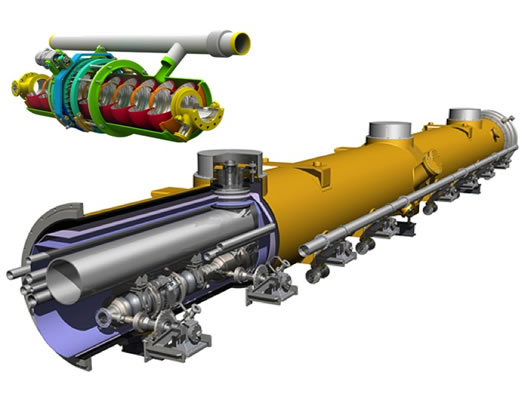The Machine
NGLS is planned as a multi-beamline soft X‐ray FEL array powered by a superconducting linear accelerator, operating with a high bunch repetition rate of approximately one MHz. Choices for beam energy and pulse repetition rates necessitate the adoption of continuous-wave (CW) superconducting radio-frequency (RF) technology for the linear accelerator (linac). The superconducting linear accelerator will be supplied by an injector based on a high-brightness, high-repetition-rate photocathode electron gun. Electron bunches will be distributed from the linac to the array of independently configurable FEL beamlines with nominal bunch rates up to 100 kHz in each FEL, and with even pulse spacing, and some beamlines capable of operating at MHz repetition rates. Individual FELs may be configured for different modes of operation, and each may produce high peak and average brightness X-rays with a flexible pulse format, and with pulse durations ranging from sub-femtoseconds to hundreds of femtoseconds.

Schematic layout of the main components of the planned NGLS machine, showing the major components: the injector, laser heater, cryomodules containing the CW superconducting cavities, linearizer and bunch compression systems, and electron bunch distribution through a beam spreader. Each branch of the spreader houses an independent FEL, followed by X-ray beamlines and end stations (not shown).
The CW superconducting linac will provide a “backbone” for delivering high-brightness and high-repetition-rate electron beams to an array of independent FELs, the number of which may be expanded in the future. The machine will be designed for maximum bunch charge of 300 pC and nominal 1 MHz repetition rate (i.e., an average current of 300 µA), and with upgrade paths consistent with a range of lower bunch charge at increased rate while maintaining average current. A wide variety of bunch time structures will be accommodated by the injector and linac, and our conceptual design allows flexibility to increase versatility in performance. The nominal electron beam energy of 2.4 GeV has been chosen so as to be able to produce tunable FELs with up to 3 keV photons in the fundamental, and higher photon energies in the harmonics.

The NGLS approach to the CW superconducting linac will be to maximize use of existing expertise, designs, infrastructure, and industrialization. Engineering developments will be needed to meet NGLS requirements, reduce costs, and deliver a reliable and cost-effective CW superconducting electron linac.
Partner laboratories with expertise in superconducting RF systems and RF power systems will be responsible for the linac cryomodules, cryogenics systems, and RF power and distribution systems.
![]()
![]()
![]()
The photo-gun is being designed to operate at 1 MHz repetition rate and deliver the nominal 300 pC bunch charge into an injector cryomodule. The linac will accept electron bunches from the injector, and provide acceleration up to ~2.4 GeV, and bunch compression, before directing the beam to the spreader for distribution into the separate FEL undulator lines. The linac, based on the choice of existing 1.3 GHz TESLA-like superconducting cavity technology, will consist of seven main sections. The first section, the laser heater, will interface the linac with the injector, and provide control of the beam energy spread and stabilize the beam dynamics. The beam will then be accelerated in Linac 1, conditioned by passage through a 3.9 GHz third-harmonic RF structure, compressed through a single-chicane bunch compressor, and then further accelerated in Linac 2. A second bunch compressor would allow for further manipulations of the longitudinal phase space, and the final energy of 2.4 GeV would be achieved in Linac 3, the last linac section. Following the linac will be a beam spreader, designed to deliver individual bunches to the array of FELs, using a series of deflecting radio-frequency cavities and electron beam transport lines.

